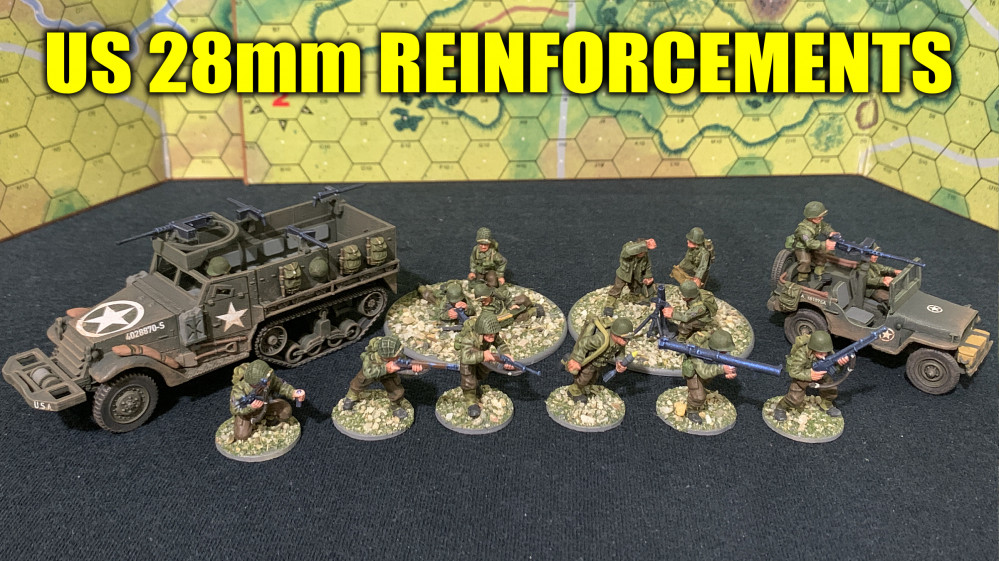
Oriskany's US 28mm Reinforcements
Naval Command: Falklands
I’ve spent most of today gearing up Rory Crabb’s Naval Command system for play in the Falklands War. With a ground scale of 1cm = 1 nautical mile (roughly 1:180,000) this is really the only kind of game that even comes close to representing the scope of modern naval operations. In physical play, the table is usually 6 ‘ x 4’, and the ships re often 1:3000 with groups of aircraft represented by counters at 1:300 or 1:600. (6mm or 3mm).
Of course, to facilitate play online or take screen shots to use in battle reports of use in future Ops Center episodes, I’ve been building everything virtually.
Of course, given the historical course of events, this kind of thing might wind up being more of a “campaign tracker” than an actual live game. Then again, we can always run with the suggestion of a hypothetical game where the Argentinian Navy masses together for one all-out strike at the British, and we actually get the latter-day sea battle that (thankfully) never really happened.
Let me know what you think, or whether you’d ever be interested in trying this out over the next couple of weekends online.
 Starting off, I have a 10-foot map here (120 inches across, each grid is 1"). So, converting the game from centimeters to inches, I'm landing on ROUGHLY 1" = 2nm, which is what is scaled out here. Obviously the ships are not to scale with the map (although they are to scale with each other). Same with the aircraft, with a yellow dot in the center of each piece showing the group's actual location on the map. This map shows just about everything the two sides had INITIALLY, although of course they were never all crammed this close to the Falklands all at once like this. This is meant simply as a staging file, which can be copied and used to quickly build future scenarios by selecting items off this "shopping list." Or, we could run an alternate history all-out sea clash ...
Starting off, I have a 10-foot map here (120 inches across, each grid is 1"). So, converting the game from centimeters to inches, I'm landing on ROUGHLY 1" = 2nm, which is what is scaled out here. Obviously the ships are not to scale with the map (although they are to scale with each other). Same with the aircraft, with a yellow dot in the center of each piece showing the group's actual location on the map. This map shows just about everything the two sides had INITIALLY, although of course they were never all crammed this close to the Falklands all at once like this. This is meant simply as a staging file, which can be copied and used to quickly build future scenarios by selecting items off this "shopping list." Or, we could run an alternate history all-out sea clash ... The Argentinian carrier task force, comprised of the ARA Veinticinco de Mayo and her escorts. You can see where the carrier has launched four Skyhawks on a strike mission (S-4, historically this never happened), while keeping four Skyhawks back in CAP in a "fighter" configuation (F-4). Sea King ASW (antisubmarine warfare) helos have also been launched, as well as an S-2 Tracker, keeping a wary eye out for HMS Splendid (submarine sent to sink Veinticinco de Mayo) or other British warships. Aircraft are huge in this game. Detection and electronic warfare are everything. There is no armor, and all weapons automatically hit, if they find you and reach you. Your "armor" is your electronics. Welcome to modern naval warfare.
The Argentinian carrier task force, comprised of the ARA Veinticinco de Mayo and her escorts. You can see where the carrier has launched four Skyhawks on a strike mission (S-4, historically this never happened), while keeping four Skyhawks back in CAP in a "fighter" configuation (F-4). Sea King ASW (antisubmarine warfare) helos have also been launched, as well as an S-2 Tracker, keeping a wary eye out for HMS Splendid (submarine sent to sink Veinticinco de Mayo) or other British warships. Aircraft are huge in this game. Detection and electronic warfare are everything. There is no armor, and all weapons automatically hit, if they find you and reach you. Your "armor" is your electronics. Welcome to modern naval warfare.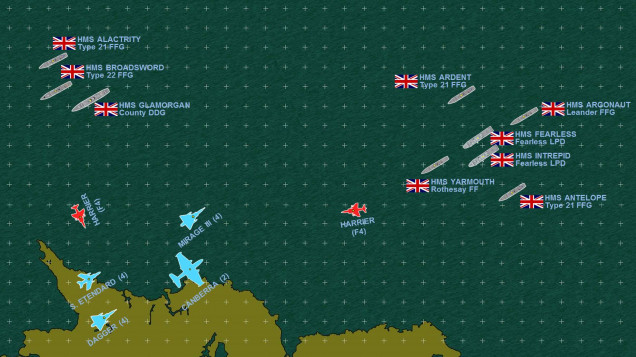 The spearhead of the British amphibious landing force approaches the north coast of East Falkland, and is about to attacked by a major Argentinian air strike launched off the mainland. Those British destroyers and frigates have SAMs at the ready, however, and of course two flights of FRS1 Sea Harriers are vectoring in to intercept. The Mirage IIIs and Daggers will mix up in a dogfight, while the Canberras and Etendards make their bombing runs.
The spearhead of the British amphibious landing force approaches the north coast of East Falkland, and is about to attacked by a major Argentinian air strike launched off the mainland. Those British destroyers and frigates have SAMs at the ready, however, and of course two flights of FRS1 Sea Harriers are vectoring in to intercept. The Mirage IIIs and Daggers will mix up in a dogfight, while the Canberras and Etendards make their bombing runs.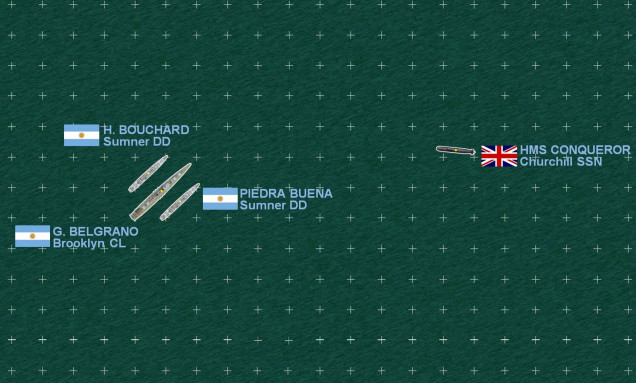 The one major part of the naval war that really did happen, the fateful encounter between the British nuclear submarine HMS Conqueror and the Argentinian cruiser Belgrano. Note there are no ASW helos launched, dropping sonobuoys or ASW torpedoes. That's because Belgrano is an old American WW2 light cruiser, and her escorts are old American WW2 Sumner class destroyers. No helicopter pads. Not good. In modern naval combat, helicopters play an absolutely crucial role - not so much in combat, but in keeping your fleet safe, and keeping you informed.
The one major part of the naval war that really did happen, the fateful encounter between the British nuclear submarine HMS Conqueror and the Argentinian cruiser Belgrano. Note there are no ASW helos launched, dropping sonobuoys or ASW torpedoes. That's because Belgrano is an old American WW2 light cruiser, and her escorts are old American WW2 Sumner class destroyers. No helicopter pads. Not good. In modern naval combat, helicopters play an absolutely crucial role - not so much in combat, but in keeping your fleet safe, and keeping you informed.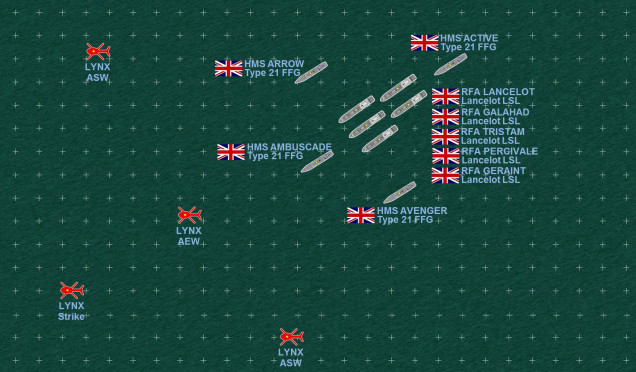 In contrast, the leading element of the British support fleet (made up of five "Round Table" logistic support ships - escorted by British frigates) has plenty of helo support. Each of these little British warships carries a Lynx helicopter, which can be configured for ASW, AEW (airborne early warning), strike, or transport roles. The Argentinian Navy did have a handful of older submarines, only one of which (ARA Santa Fe) had so far been accounted for. When it comes to enemy submarines, caution is always a good idea.
In contrast, the leading element of the British support fleet (made up of five "Round Table" logistic support ships - escorted by British frigates) has plenty of helo support. Each of these little British warships carries a Lynx helicopter, which can be configured for ASW, AEW (airborne early warning), strike, or transport roles. The Argentinian Navy did have a handful of older submarines, only one of which (ARA Santa Fe) had so far been accounted for. When it comes to enemy submarines, caution is always a good idea.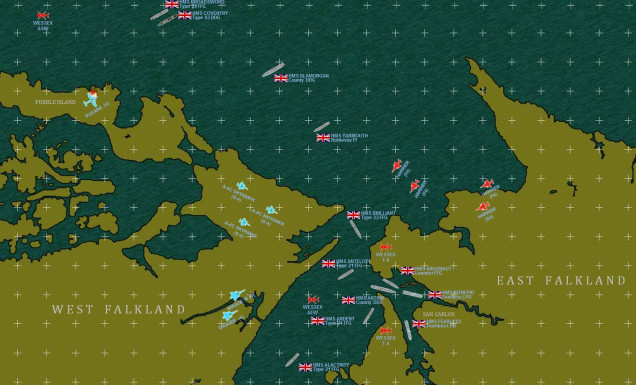 Here's a little bit of a zoom-in where things get really tight. This is a ROUGH historical approximation of the initial British landings at San Carlos. Note there are NO Argentinian ships, by now they were fighting this naval war almost entirely by air. But these airstrikes were incredibly ferocious, the British would soon call San Carlos "Bomb Alley." At least six of these British ships would be hit and three of them sunk, although Argentinian aircraft losses were also high. We also see burning "Pucara" ground attack aircraft to the northwest at Pebble Island, where SAS and SBS had landed and blown up the airfield there. Meanwhile, landings are underway, first of SAS in Gazelles (some shot down), then 3 Para and 42 Commando to the east and 40 Commando and 3 Brigade HQ to the south. 1 Para and 45 Commando would follow up.
Here's a little bit of a zoom-in where things get really tight. This is a ROUGH historical approximation of the initial British landings at San Carlos. Note there are NO Argentinian ships, by now they were fighting this naval war almost entirely by air. But these airstrikes were incredibly ferocious, the British would soon call San Carlos "Bomb Alley." At least six of these British ships would be hit and three of them sunk, although Argentinian aircraft losses were also high. We also see burning "Pucara" ground attack aircraft to the northwest at Pebble Island, where SAS and SBS had landed and blown up the airfield there. Meanwhile, landings are underway, first of SAS in Gazelles (some shot down), then 3 Para and 42 Commando to the east and 40 Commando and 3 Brigade HQ to the south. 1 Para and 45 Commando would follow up.






























![TerrainFest 2024 Begins! Build Terrain With OnTableTop & Win A £300 Prize! [Extended!]](https://images.beastsofwar.com/2024/10/TerrainFEST-2024-Social-Media-Post-Square-225-127.jpg)










































Leave a Reply